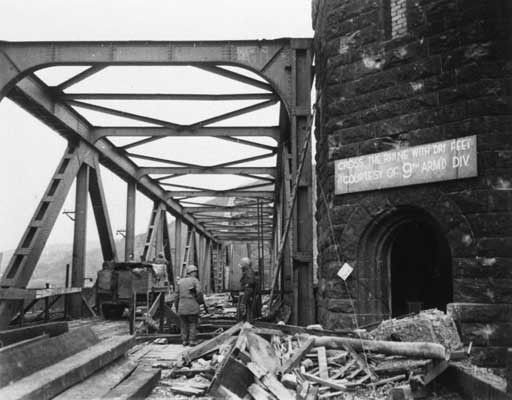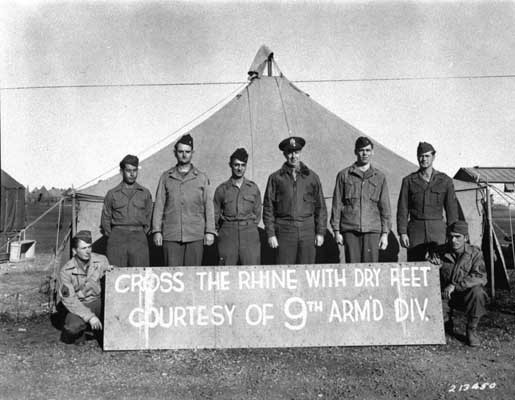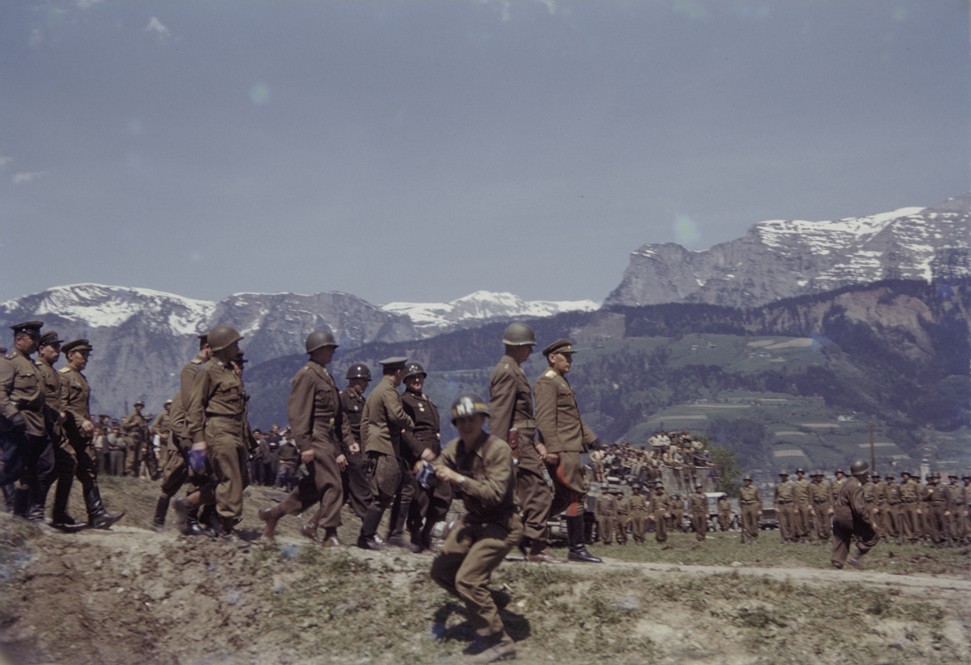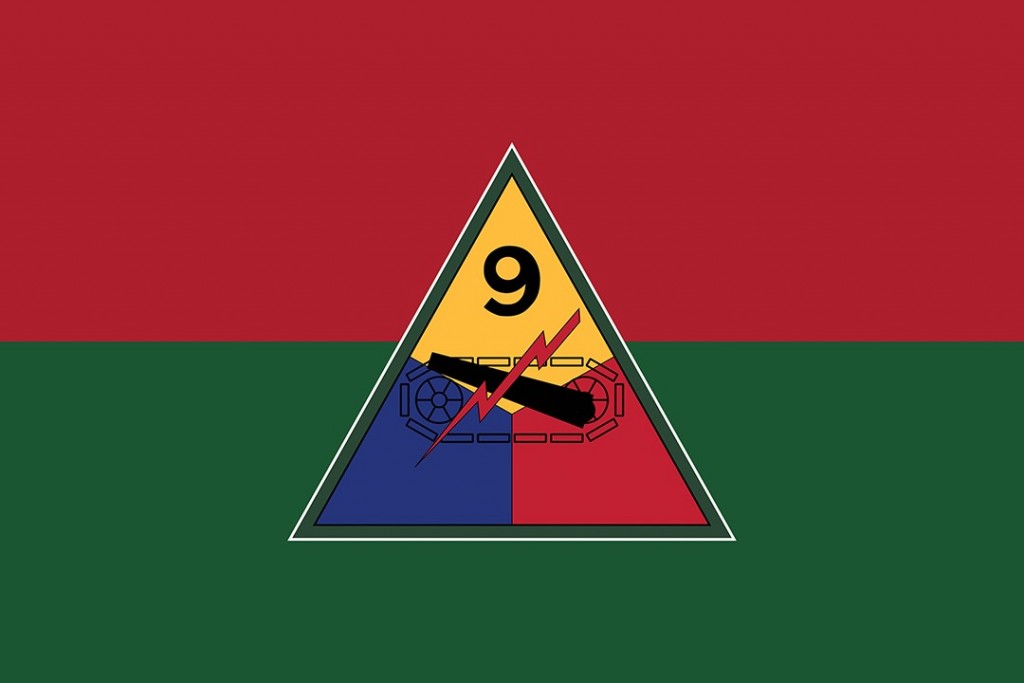
The 9th Armored Division during World War II
In 1985, the United States Holocaust Memorial Museum and the US Army Center of Military History began a program to honor US Army divisions that took part in the Allied liberation of Nazi camps. The US Army Center of Military History defines a liberating division as one whose official records show its presence at a camp within 48 hours of the first soldier’s arrival. The 9th Armored Division is among the 36 US divisions that have been recognized to date.
Key Facts
-
1
US, British, Soviet, and Canadian troops encountered concentration camps and other sites of Nazi crimes as they advanced across Europe in 1944 and 1945.
-
2
The Allied soldiers liberated sick and starving camp prisoners from Nazi tyranny. They also provided them with food, clothing, and medical aid.
-
3
The United States Holocaust Memorial Museum and the US Army Center of Military History have recognized 36 US divisions for their role in the liberation of Nazi camps.
9th Armored Division Campaigns During World War II
The 9th Armored Division (nicknamed the “Phantom” division) was formed in July 1942. In early fall 1944, the division landed in Normandy, France. It was immediately deployed eastward across France to Luxembourg. During the Battle of the Bulge, the German army immediately attacked the “Phantom” division. After a week of fighting, the 9th Armored Division was initially forced to withdraw, but it went on to defend the city of Bastogne, Belgium. On March 7, 1945, the division captured the Ludendorff Bridge and crossed the Rhine River in the German city of Remagen. The 9th continued its drive into central Germany toward the city of Leipzig. When the war in Europe ended on May 8, 1945, the 9th Armored Division was fighting the German army between the towns of Falkenau an der Eger (in Czech, Falknov nad Ohří; now Sokolov) and Cheb in present-day Czech Republic. By this point, the 9th Armored Division had joined with the 1st Infantry Division.
The 9th Armored Division and the Liberation of the Zwodau Subcamp
On May 7, 1945, troops of the 9th Armored Division, along with soldiers from the 1st Infantry Division, liberated Zwodau. At the time, Zwodau was a subcamp of the Flossenbürg concentration camp.
Location of the Zwodau Subcamp
The Zwodau subcamp was located in the small town of Zwodau (in Czech, Svatava) about 10 miles southwest of Karlsbad (in Czech, Karlovy Vary) in the Sudetenland. The Sudetenland was a region of Czechoslovakia that had been annexed by Nazi Germany in fall 1938 in accordance with the Munich Agreement. Today this area is part of the Czech Republic. The nearest larger town to Zwodau was Falkenau an der Eger.
History of the Zwodau Subcamp
SS authorities established the Zwodau subcamp in 1944. The first inmates were non-Jewish female prisoners sent from the Ravensbrück concentration camp. These first prisoners were forced to build the barracks and other camp infrastructure. Eventually, a number of Jewish women from Hungary were also imprisoned in Zwodau. Prisoners in the subcamp were forced to work in factories producing airplane equipment for the German war effort. For most of its history, the prisoner population of this subcamp numbered in the hundreds.
In spring 1945, Zwodau became increasingly overcrowded. At this time, the SS was evacuating prisoners from other camps in the vicinity on death marches. Many of these marches were directed towards Zwodau, which was farther from the front lines. Some death marches stopped briefly in Zwodau before continuing on to other camps. Others remained there. In April 1945, the prisoner population reached between 2,500 and 3,000. Many of the new prisoners were Jewish women. In the final weeks of the camp's operation, the death rate among prisoners rapidly increased due to the spread of disease and the lack of food and water.
The SS attempted to evacuate and dismantle Zwodau in late April 1945. Around April 20, they forced the prisoners on a march, only to turn them back several days later. The prisoners returned to a camp that was mostly demolished.
When American troops liberated the Zwodau subcamp in early May 1945, they found the prisoners in very poor physical condition. Troops also encountered a number of other prisoners in the region around Falkenau an der Eger, including prisoners of war.
Recognition as a Liberating Division
The 9th Armored Division was recognized as a liberating unit by the US Army's Center of Military History and the United States Holocaust Memorial Museum in 1993.
9th Armored Division Battle Casualty Figures
Hundreds of thousands of US servicemen and women died or were wounded in the fight against Nazi tyranny.
The total number of battle casualties for the 9th Armored Division in the European Theater of Operations during World War II was 3,845. In this case, “battle casualties” includes all personnel who were unable to fight in battle because they were wounded, missing, captured, or killed.
Among the battle casualties suffered by the 9th Armored Division, there were 728 deaths.
9th Armored Division Nickname and Insignia
Although no nickname for the 9th was commonly used throughout the war, the name "Phantom" division was sometimes used in 1945. This nickname probably originated during the Battle of the Bulge. During the battle, the 9th Armored Division appeared to be like a phantom, seemingly everywhere along the front. Some accounts indicate that larger US armored divisions referred to the 9th as “Little Brother.”
The patch or insignia of the 9th Armored Division is shaped like a pyramid and represents power. In the center of the patch are three intertwined symbols: a tank tread, a cannon, and a lightning bolt. The tank tread symbolizes mobility. The cannon represents firepower. And the lightning bolt stands for shock action (a quick, offensive, military attack that surprises the enemy). The three symbols are placed against a tricolored background comprised of yellow, red, and blue. These colors represent key components of an armored division: cavalry (yellow), field artillery (red), and infantry (blue). The division number appears in black near the top of the pyramid (against the yellow part of the patch).
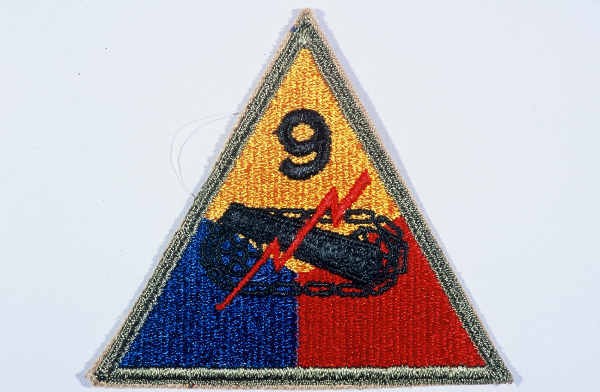
Footnotes
-
Footnote reference1.
In the aftermath of World War II, the US Department of the Army compiled casualty figures for US Army personnel. The US government published these figures in 1953. The report listed casualty numbers for the US Army for the period from December 7, 1941 (Pearl Harbor) through December 31, 1946, when US President Harry S. Truman officially declared the end of war hostilities. Army Battle Casualties and Nonbattle Deaths: Final Report, 7 December 1941-31 December 1946, Prepared by the Statistical and Accounting Branch, Office of the Adjutant General, Under the Direction of the Program Review and Analysis, Division of the Comptroller of the Army, O.C.S., (Washington: Department of the Army, 1953), p. 3-4, 84-89.
Critical Thinking Questions
What challenges did Allied forces face when they encountered the camps and sites of other atrocities?
What challenges faced survivors of the Holocaust upon liberation?


